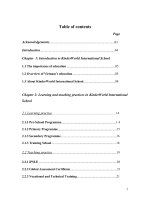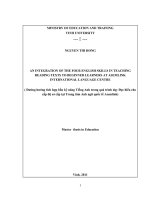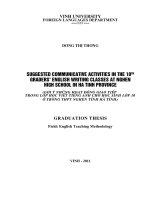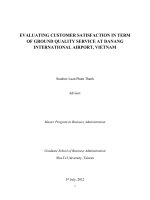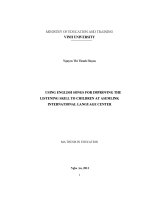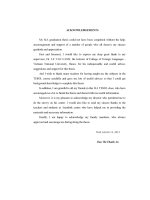Ineffective secondary esl teaching at shine international school ba ria campus
Bạn đang xem bản rút gọn của tài liệu. Xem và tải ngay bản đầy đủ của tài liệu tại đây (1.03 MB, 66 trang )
UNIVERSITY OF ECONOMICS HO CHI MINH CITY
International School of Business
------------------------------
Bui Le Phuong Thao
INEFFECTIVE SECONDARY
ESL TEACHING AT SHINE
INTERNATIONAL SCHOOL - BA RIA
CAMPUS
MASTER OF BUSINESS ADMINISTRATION
Ho Chi Minh City - 2021
UNIVERSITY OF ECONOMICS HO CHI MINH CITY
International School of Business
------------------------------
Bui Le Phuong Thao
INEFFECTIVE SECONDARY
ESL TEACHING AT SHINE
INTERNATIONAL SCHOOL - BA RIA
CAMPUS
MASTER OF BUSINESS ADMINISTRATION
SUPERVISOR: DOCTOR NGUYEN PHONG NGUYEN
Ho Chi Minh City – 2021
2
ACKNOWLEDGEMENT
I would like to express my thanks to my supervisor, Doctor Nguyen Phong Nguyen, for
supporting me. During the time of doing the thesis, his advice helps me get through all
my work mistakes.
My completion of this project could not have been accomplished without the support of
the Board of managers of SHINE BR, Mr. Ngoc, Mr. Duc, Ms. Duyen, Ms. Hong.
Thanks should also go to my friendly colleagues.
Furthermore, I would like to express my sincere thanks to UEH – International School
of Business for having me on this fantastic journey. It is my pleasure to be a member of
the glory ISB.MBA cohort 10.
3
Table of Contents
ACKNOWLEDGEMENT ............................................................................................ 3
LIST OF ABBREVIATIONS....................................................................................... 6
LIST OF TABLES ........................................................................................................ 6
Executive summary ....................................................................................................... 7
Chapter 1. Background ................................................................................................ 8
1.1.
Company background ....................................................................................... 8
1.2.
Symptoms ............................................................................................................ 9
1.2.1. High student mobility rate in Secondary.............................................................. 9
1.2.2. A high number of parent complaints.................................................................. 12
1.2.3. Low parent satisfaction in Secondary ................................................................ 13
1.2.4. The importance of the symptoms ....................................................................... 14
Chapter 2. Problems identification ............................................................................ 17
2.1. Potential problems ............................................................................................... 17
2.1.1. Secondary ESL teaching is ineffective ............................................................... 17
2.1.2. Secondary Vietnamese teachers can not adapt to parent's need .......................... 19
2.1.3. Tuition fee is high ............................................................................................... 20
2.1.4. Old school facility ............................................................................................... 21
2.2. Central problem validation ................................................................................. 24
2.2.1. Manager's perspectives ....................................................................................... 24
2.2.2. Customer's perspectives: ..................................................................................... 25
2.2.3. Central problem is selected to be solved ............................................................. 25
2.3. Central problem definition 'Ineffective Secondary ESL teaching'.................. 25
2.4. Problem existence ................................................................................................. 26
2.5. Problem importance (Consequences) ................................................................. 28
Chapter 3. Causes validation and solutions .............................................................. 31
3.1. List of real causes ................................................................................................. 31
3.1.1. Initial list of causes.............................................................................................. 31
3.1.2. Qualitative research findings............................................................................... 33
4
a. Lack of experienced teachers .................................................................................... 34
b. Lack of using the teaching aid .................................................................................. 34
c. Lack of effective training .......................................................................................... 35
d. Curriculum is not stable ............................................................................................ 36
3.1.3. Causes evaluation ................................................................................................ 36
3.2. The set of solutions ............................................................................................... 38
3.3. Change plan design .............................................................................................. 43
3.3.1. Objective ............................................................................................................. 43
3.3.2. Targeted outcomes .............................................................................................. 44
3.3.3. Action plan implementation ................................................................................ 44
References .................................................................................................................... 48
Appendix 1: Interview Guide ..................................................................................... 53
Appendix 2: The transcript – Campus Principal ..................................................... 55
Appendix 3: The transcript – Academic Vice-principal .......................................... 59
Appendix 4: The transcript – Head of Student Care Department ......................... 62
Appendix 5: The transcript – Head of Admission Department .............................. 64
Appendix 6: The transcript – Parents and Student ................................................. 66
5
LIST OF ABBREVIATIONS
1
2
3
ESL
Moet
SHINE BR
English as a Second Language
Ministry of Education and Training program
SHINE international school – Ba Ria Campus
LIST OF TABLES
Table 1. Student mobility in grade ................................................................................ 12
Table 2. The result of the school survey - December 2020 .......................................... 14
Table 3. The result of the school survey ....................................................................... 18
Table 4. ESL standard at SHINE international school system...................................... 27
Table 5. ESL assesment statistics - December 2020 ..................................................... 28
Table 6. Summary of causes evaluation ........................................................................ 37
Table 7. Alternative solution 1 in steps ......................................................................... 39
Table 8.Alternative solution 2 in steps .......................................................................... 41
Table 9.Alternative solution 3 in steps .......................................................................... 42
Table 10. Action plan .................................................................................................... 47
LIST OF FIGURES
Figure 1. Revenue distribution of SHINE International School System in 2019 – 2020 8
Figure 2. The Organizational Structure of SHINE BR – 2021 ....................................... 9
Figure 3. The number of student mobility in SHINE BR, 2016 - 2020 ........................ 10
Figure 4. Student mobility rate in SHINE BR, 2017 - 2021 ......................................... 11
Figure 5. Student mobility rate in SHINE International School System 2019 - 2020 .. 11
Figure 6. The number of parent complaints, June 2020 to March 2021 ....................... 12
Figure 7. The initial cause-effect map........................................................................... 23
Figure 8. The updated cause-effect map ....................................................................... 30
Figure 9. The final cause-effect map............................................................................. 37
6
Executive summary
In Vietnam, education is always considered the most important. Vietnamese put a very
high value on education, and households are inclined to spend a significant amount of
resources on their children's education (1). Education is also a service supplier, parents
or students are the school's customers, and parents are the key decision-makers. Hence,
SHINE BR has low parent satisfaction, a high student mobility rate, and a high number
of parent complain. The research focuses on finding the main problem, following finding
the critical cause, and proposed the best alternative solution to solve the cause to help
SHINE improve the performance.
To find the issue that SHINE BR is challenging, the author conducted in-depth
interviews with the school's Board of managers, unsatisfied parents, and 'mobility
students'. Through in-depth interviews, using the figures and data from SHINE BR,
relevant literature, and advice from the Campus Principal, the root cause was determined
as ineffective Secondary ESL teaching. After further rounds of interviews and literature
support, the potential causes that affect the central problem are lack of experienced ESL
teachers, lack of using teaching aid, lack of effective training, and curriculum is not
stable. Following investigating and in-depth interviews, the root cause is determined to
lack of effective training.
The possible alternative solutions for improvement of lack the effective training are Reevaluating and enhancing online training effectiveness, Development training and
professional development plan for ESL teacher, Promulgating policies to encourage selftraining. Basing on the cost-benefit analysis, the development training and professional
development plan for ESL teachers is feasible to solve the ineffective Secondary ESL
teaching at SHINE BR. The solution is to benefit from available resources, which cost
around VND 900,000,000 plus training cost and long-term. This solution not only
improves the ESL teaching effectiveness but also increases the school’s reputation.
7
Chapter 1. Background
1.1. Company background
From the 2020 – 2021 academic school year, SHINE BR's vision is to become a worldclass bilingual school. By choosing the Human education philosophy, placing people in
the center of life, SHINE BR carries the mission of training the generations who have
outstanding intelligence, soul, fitness, and skills to live happily, international integration,
and become responsible global citizens. SHINE BR also has six core values that focus
on developing good moral foundations amongst students, which include: Integrity,
Prestige, Romance, Harmony, Kindness, and Leadership.
SHINE BR offers a bilingual teaching and learning program encompassing the
Vietnamese Ministry of Education and Training program (MoET program) and the
English as Second Language program (ESL program). ESL Program is the key selling
point of SHINE BR. According to a school survey in 2019, 80% of parents said they
chose SHINE BR as the ESL program.
Established in 2016, up to May 2021, SHINE BR has 1,090 students from kindergarten
to grade 12 and more than 300 teachers & staff. SHINE BR has always been one of the
essential units of SHINE International School System, contributing 49% to SHINE
International School System's revenue.
21%
22%
2%
6%
49%
SHINE HL
SHINE HUE
SHINE DN
SHINE BR
SHINE SG
Figure 1. Revenue distribution of SHINE International School System in 2019 – 2020
(Source: Financial Department of SHINE International School System)
SHINE BR includes Operation Block and Academic Block, which detail departments
was shown in the following figure 'the organizational structure'. In which departments,
8
the Student Care department takes responsibility for taking care of customers (parents,
students) and rating students change schools for reasons other than getting promoted to
the next grade in a new building (also known as student mobility). Academic Block
focuses on teaching and learning, program curriculum, and student activities.
CAMPUS PRINCIPAL
OPERATION
BLOCK
Admission
Department
Finance
Department
HR
Department
ACADEMIC
BLOCK
Facility
Department
Student Care
Department
Kindergarten
Primary
Secondary &
Highschool
ESL
Figure 2. The Organizational Structure of SHINE BR – 2021
(Source: HR department of SHINE BR)
1.2. Symptoms
1.2.1. High student mobility rate in Secondary
Mobility in education can mean families move from city to city or state to state as
employment and housing change. However, it can also mean families move their
children from one school to another within the same area for other, more personal
reasons (2). In this research, we focus on the second meaning of student mobility. In
summary, a student who does not continue to enroll in SHINE BR calls student mobility.
Two waves of the Covid-19 pandemic in Vietnam in 2020 and 2021 make the education
industry faces difficulties in admission. To understand SHINE BR's real problem, the
author explores the yearly report of SHINE BR and realized that the student mobility
rate in the 2019 - 2020 academic school year is higher than the statistic in history. The
student mobility rate is still high in the first semester of the 2020 – 2021 academic school
year (10%). Student mobility's rate is highest over the past four years:
9
Number of student mobility
Total student
950
1000
900
800
700
600
500
800
600
350
400
300
200
100
0
150
50
30
40
2016 - 2017
2017 - 2018
2018 - 2019
2019 - 2020
Figure 3. The number of student mobility in SHINE BR, 2016 - 2020
(Source: Student Care department of SHINE BR)
In many years, SHINE BR has always been one of the best admission schools. The
student mobility rate always keeps less than 5% per year; SHINE BR targets to control
the student mobility rate is less than 5%. Additionally, the student mobility rate of
SHINE BR's competitor is less than 10% (VA School is 8%; SIS is 6%, source: school's
market research - 2020).
According to the internal data, the student mobility rate in SHINE BR in the 2019 – 2020
academic school year is higher than the expectation, which is 16%. The student mobility
rate in the first semester of the 2020 – 2021 academic school year is 10%, and it is
estimated up to 20% at the end of the 2020 – 2021 academic school year. A high student
mobility rate is a symptom that is easy to recognize and reflects some implicit issues.
Mr. Ngoc – Campus Principal said that:
"As the yearly report that you have seen from the financial department, since
2019, the school business has become difficult. The number of students who move
out of our school (mobility) is increasing and reach the highest rate ever after."
The below table clearly shows the student mobility rate in SHINE BR from 2017 to 2021.
10
25%
20%
20%
16%
15%
10%
5%
5%
5%
2017 - 2018
2018 - 2019
0%
2019 - 2020
2020 - 2021
Student mobility rate
Figure 4. Student mobility rate in SHINE BR, 2017 - 2021
(Source: Student Care Department of SHINE BR)
Number of student mobility
Number of Student
1200
1000
800
950
600
400
200
0
600
500
400
5
SHINE HL
150
SHINE BR
49
SHINE DN
100
5
SHINE HUE
20
SHINE SG
Figure 5. Student mobility rate in SHINE International School System 2019 - 2020
(Source: SHINE International School System)
As considered in the system, SHINE BR also has the highest student mobility rate.
As an introduction, SHINE BR is an international school from kindergarten to grade 12,
each level/ class have their own specific. Answer for the question "In which grade the
highest student mobility rate?", Mr. Ngoc – Campus Principal responds:
"The Secondary has the highest student mobility rate. The exact number you can
find in the Student Care Department."
11
The following table shows the number of student mobility in grade:
2019 - 2020
2020 - 2021
Kindergarten
23
19
Primary
37
28
Secondary
60
48
Highschool
30
17
Total
150
112
Table 1. Student mobility in grade
(Source: Student Care Department of SHINE BR)
Ms. Hong – Head of Student Care department shared:
"The total number of student mobility in the Secondary is 60 (2019 – 2020), and
in the first semester of this academic school year, the number is 48. Grade nine
has the highest student mobility's rate."
The Secondary has the highest student mobility rate, 40% (60/150 students).
As interview Ms. Duyen – Head of Admission Department:
"The number of student mobility in the 2019 – 2020 academic school year was
concentrated in January 2020 (after the first semester), before the Covid-19.
Therefore, the data was not impacted by the COVID-19 situation."
In summary, the first symptom was explored is the high student mobility rate in
Secondary.
1.2.2. A high number of parent complaints
35
30
25
20
15
10
5
-
17
25
15
31
SHINE HL
SHINE HUE
SHINE DN
SHINE BR
Figure 6. The number of parent complaints, June 2020 to March 2021
(Source: SHINE International School System's Customer Care department)
12
According to the Customer Care Department of SHINE International School System
report, from July 2020 to March 2021, SHINE BR has the highest number of parent
complaints.
Mr. Ngoc:
"Not only the complaints from Customer Care department of headquarters, but
the complaints directly to our Campus's Student Care department is also so
much."
Because some parent hides their information when they send the complaints to the
Customer Care department of SHINE International School System, the author cannot
clarify which grade has the highest number of parent complaints.
Mr. Ngoc:
"Most of the complaints sent to Customer Care of headquarters will be anonymous,
the complaints at the school do not have a record, so it is not possible to calculate
which grade level has the most complaints."
1.2.3. Low parent satisfaction in Secondary
For children and young people, the family is an essential factor in educational and
developmental support. It is regarded as the primary socialization instance. A place of
learning in terms of knowledge and skills is made available. Through this Place of
learning, a family can directly or indirectly influence the extent to which the children use
the school's educational opportunities according to their skills and whether or not they
reach their potential (3).
According to Kotler and Keller (4), satisfaction is feeling happy or disappointed
someone who arises because of comparing the perceived performance of the product (or
result) to their expectations. This term is often used to measure how the products and
services provided by the company meet or exceed customer expectations.
While according to Njei Zephan (5), customer satisfaction can be understood as the
difference between customer expectation before consumption and realization after
consumption of product or service.
As the result of the school survey at the end of the first semester, December 2020, it is
13
shown that parent satisfaction at SHINE BR is low.
AVERAGE
3.6
Kindergarten
3.87
Primary
3.88
Secondary
2.87
Highschool
3.04
Table 2. The result of the school survey - December 2020
(Source: SHINE BR)
1 = Strongly dissatisfaction
2 = Dissatisfaction
3 = Neutral
4 = Satisfaction
5 = Strongly satisfaction
The score of parent satisfaction is neutral, the score of Secondary's parent satisfaction is
less than neutral.
Customers are always at the receiving end of the services of the company. If they are
satisfied with the organization's service, they stay and become loyal, and the organization
benefits in terms of revenues, and so on (6).
As the answer of a dissatisfied parent who is a mother of a Secondary student:
"I was very disappointed when I enrolled in this school. I had high expectations for
the program. Among them is the quality of English teaching. There is much time
for ESL in students' timetables, but teachers' quality is not good. Especially foreign
teachers."
1.2.4. The importance of the symptoms
A high student mobility rate could lead to other harmful consequences. Student mobility
not only can harm the students who change schools, but it can also harm the classrooms
and schools they attend (2). Student mobility has "potentially deep and pervasive
consequences" for individual students and the schools they attend (7).
14
A group interview was carried out with the school's Board of managers who take
responsibility for student mobility rate to determine the consequence of symptoms.
As responses of Mr. Ngoc – Campus Principal:
“In education, both the finance index and the non-finance index reflect the school's
quality. Student mobility rate is an essential element in the financial index: the
higher the student mobility rate, the lower the financial performance. Our campus
also sets up KPI for all teachers and staff to control the student mobility rate of less
than 5%. If not, the yearly bonus will be cut."
Ms. Duyen – Head of Admission Department, said that:
"If students left SHINE BR because they were not satisfied with the school, there
would be a bad reputation. Our school is a private school, and it is not easy to
recruit new students. 70% of our customers come from word of mouth channel.
If students leave our school because they are not satisfied with our school, there
will be a bad reputation. There are many students out in any year; the next year's
enrollment will be complicated."
Then, if any student transfers to another school, the campus had to pay the penalty.
Ms. Hong – Head of Student Care Department, added:
"Student Care Department takes responsibility for taking care of customers (parent,
students) and controls student mobility. According to company rules, if any student
transfers to another school, the campus must pay the penalty."
Existing research finds that students can suffer psychologically, socially, and
academically from mobility. Mobile students face the psychological challenge of coping
with a new school environment (8).
In summary, a high student mobility rate is an essential symptom at SHINE BR.
The first symptom of SHINE BR is a high student mobility rate in Secondary. In an
interview with Mr. Ngoc - Campus Principal, the parent is the main decision-maker in
the student's school choosing in Secondary. Parent satisfaction has a strong effect on
student mobility.
15
"In my experience, in Secondary, students do not take many stances in this case,
the parent is the decision-maker. Parent satisfaction is critical in student mobility's
decision. According to our school survey, dissatisfied parents will give a low score
on the question of whether they want to stay with the school" – Mr. Ngoc.
Sharing by Ms. Hong – Head of Student Care Department:
"Parents are dissatisfied with SHINE BR is the main reason they transfer their
students to another school. One of our important tasks is to keep parents feel
satisfied with the school."
Parent satisfaction plays a vital role in school performance. Good customer satisfaction
affects the profitability of nearly every business. For example, when customers perceive
a good product/service, each will typically tell nine to ten people. It is estimated that
nearly one-half of American business is built upon this informal, "word-of-mouth"
communication (9). Additionally, attracting new customers could cost six times more
than retaining an old one (10).
Parent satisfaction is important because the Individuals with Disabilities Education Act
states that parents must be on decision-making teams in all special education services;
parents have various due process mechanisms to pursue if they believe they do not
receive the needed services (11). High-level satisfaction will have a lower impact on
intention to switch. Customer satisfaction gives influence toward intention to switch
(12). Fornelli (13) found that high customer satisfaction will increase loyalty for the firm
and that customers will be less prone to overtures from the competition. At a glance,
customer satisfaction is a crucial component of a business strategy, and customer
retention and product repurchase (14). According to Martins et al. (15) shows switching
barriers, service performance, and perceived value in carriers' offers, satisfaction, and
other constructs can play a pivotal role in the customer switching process among carriers
in their research.
The dissatisfied parents can easily change their school decisions (16). The result of the
school survey also shows that 91% of disappointed parents will not continually join with
SHINE BR. Details are shown in the appendix.
16
Low parent satisfaction also leads to a high rate of parent complaints.
According to Ms. Hong – Head of Student Care:
"We should not only focus on solving the current complaints without growing
parent satisfaction. The main reason why parents make a complaint is they got
disappointed. That why our school focuses on improving parent satisfaction in
advance".
As parents are the real decision-makers of selecting a school for their children, their
satisfaction becomes a crucial factor, especially when they have various choices (17).
Taking everything into account, SHINE BR needs to investigate why customer
satisfaction is low to mitigate the risk of losing students (mobility students) and
increasing the number of parent complaints.
Chapter 2. Problems identification
2.1. Potential problems
There may be some potential issues related to the school from the above symptoms and
the main symptom.
The in-depth interviews were conducted with the school's Board of managers responsible
for parent satisfaction and student mobility to explore the potential problems. The
school’s Board of managers including Mr. Ngoc – Campus Principal, Mr. Duc –
Academic Vice-principal, Ms. Hong – Head of Student Care Department, and Ms. Duyen
– Head of Admission Department. Interviews were done by face-to-face interviews.
There are some potential problems listed as follows:
2.1.1. Secondary ESL teaching is ineffective
Mr. Duc – Academic Vice Principal who is in charge of Secondary Program said that:
"I received many complaints about our quality of school program. Detailly, parents
complain that our ESL teaching is ineffective; students can not develop their
English skills. The change of ESL's curriculum also made the ESL teaching
ineffective. From 2016, the school changed ESL's curriculum yearly. The school
also changed the ESL books following the curriculum's change."
Mr. Ngoc added information:
17
"All SHINE International School System campus uses the same program, but our
teaching effectiveness is only fourth in the system (4/6). The Lack of training
for teachers when changing books/ curriculum, Lack of quality teachers'
resources are the main reasons for the ineffectiveness of teaching."
On December 2020, SHINE BR had made a parent survey to explore the reason why
parent transfers their child/ children to another school; there was 60 parent who moves
their child/ children to another school and dissatisfaction answers. According to a survey
report, the highest rate 'yes' for the question 'why did you transfer your child/ children to
another school' is 'Program'. 39% of parents transfer their child/children to another
school because of the school program.
Reasons
Yes
No
Teacher quality
31%
69%
Program quality
39%
61%
School facility
24%
76%
School performances
7%
93%
School location
12%
88%
Tuition
30%
70%
Distance
29%
71%
Future option
8%
Table 3. The result of the school survey
92%
(Source: SHINE BR)
As the feedback of the Secondary parent 1:
"I like the ESL program at SHINE, but in reality, the program being taught is
not effective. The English-using environment is not available. Our children do not
improve their English after one year of studying in SHINE BR. My children have
a good English level before joining SHINE BR."
As interview the Secondary parent 2,
"We choose to have our child study at SHINE BR because of the ESL program and
hope that they do not have to study extra English after school. However, the result
18
has not improved; my child still has to study extra English lessons in English
Center".
The author asked parent 3 to clarify her definition of the ESL Program. In their
perspective, an effective ESL program means students can have the high/ expected
achievement in learning. The ineffective program means students cannot improve their
English skills and can not adapt to the target.
It is argued that effective teaching is essential for raising student achievement (18).
As the feedback of Secondary parent one who works in the education field: I think the
essential thing that SHINE BR should fix immediately is teaching.
According to Doumani et al. (19), better product quality will maintain our high level of
customer satisfaction, which encourages customers to make future purchases. Product
quality is also one of the elements considered by customers in deciding to make a
purchase (20). Satisfaction will be obtained if the customers have a positive value that
the product is qualified. ESL teaching is one of the critical products of SHINE BR. An
effective education always plays the most vital key to making a school successful,
especially the private school.
From the above information, the exact first potential problem is that Secondary ESL
teaching is ineffective.
2.1.2. Secondary Vietnamese teachers can not adapt to parent's need
Teachers play an essential role in the lives of the students in their classrooms. A great
program can not effectively be implemented without teachers.
According to Mr. Ngoc – Campus Principal:
"Teacher is the key to improving learning; because they have a powerful impact on
the quality of student learning. Most parents complain that our Vietnamese teachers
are too young. Besides that, our teachers do not have enough adequate training to
improve their teaching skills. To control the finance, we recruit almost all young
teachers with less than two years of experience. If the school does not have any
plan for learning and developing, our teachers can not adapt to parents' needs".
Ms. Hong added: "Young teachers also are an important reason."
19
A Secondary parent shared:
"The quality of teachers is essential. My child's homeroom teacher is too young.
My child is in grade 9. It is imperative to learn with an experienced teacher."
Teachers and the quality of their teaching at school are among the most significant
determinants of parents' satisfaction with schools (21). Quality education primarily
depends on teachers and their capacity to improve the teaching and learning process. It
is widely recognized that the quality of teachers and teaching lies at the heart of all
schooling systems intending to offer quality education (22).
Even though 100% of teachers in SHINE BR get the standard of MoET, they can not
meet the need of parents.
2.1.3. Tuition fee is high
Price is a core capability for customers.
As Ms. Duyen – Head of Admission Department, shared:
"In recent years, the enrollment was difficult because of high tuition fees. Those
are also the problem of parent dissatisfaction".
Ms. Hong – Head of Student Care, also have the same statement:
"I think tuition is one of the important factors for parents to decide whether to let
their children go to school or not."
Tables 3 also show that 30% of parents transfer their children's school because of
'tuition'.
Tuition is increasing significantly from 2016 to 2020. There is no policy to control tuition
fee increases. Then parents worried that the tuition fee would continue to grow in the
upcoming year.
Ms. Duyen commented that:
"Lack of communication between our school and the financial department of
SHINE International School System (our head company) in tuition fee set up made
the tuition fee is unseasonable in our market. There is no promise to keep the same
tuition fee for current parents made our parents do not trust in our school."
One crucial factor that has been considered in many exchange relationships is price,
20
which is the financial value given out in exchange for a product. The literature on
consumer studies regarding price has argued that customers hold an internal reference
price which serves as a standard against which newly encoded prices are compared (23).
Therefore, the reference price provides a base for customers to determine their level of
satisfaction with the exchange, the so-called "Price satisfaction", which has been
explored in detail by authors such as Diller (23) in consumer markets.
According to Han et al. (24), it is possible that price suitability can support customer
satisfaction after achieving the desired level of customer benefits that encourages
customers to continue to trust and make repeat purchases. Positive perception will lead
to a feeling of satisfaction with customers. In contrast, conversely, if customers have a
negative perception, then there is a sense of dissatisfaction that causes customers to be
reluctant to buy back the product. Customer satisfaction can also be formed when
sacrifices are issued following the value received, which means the product's price
following the benefits obtained.
2.1.4. Old school facility
According to Mr. Ngoc – Campus Principal:
"The school's facilities are ancient. Every year the school tries to maintain, but
because of the limit of maintained cost, it does not improve much, while our
competitor - SIS has a good facility."
SHINE BR campus is not the new building; it was repaired from the old university. Until
2021, the building was having ten years of operation.
Physical learning environments or places where formal learning occurs range from
relatively modern and well-equipped buildings to open-air gathering places. The quality
of school facilities seems to have an indirect effect on education, an effect that is hard to
measure. Some authors argue that "extant empirical evidence is inconclusive as to
whether the condition of school buildings is related to higher student achievement after
taking into account student's background" (25).
In this case, the quality of the learning environment was strongly correlated with pupils'
achievement in Hindi and mathematics (26). In Latin America, a study that included
21
50,000 students in grades three and four found that children whose schools lacked
classroom materials and had an inadequate library were significantly more likely to show
lower test scores and higher grade repetition than those whose schools were well
equipped (27). Other studies, carried out in Botswana, Nigeria, and Papua New Guinea,
concur with these latter findings (28).
Unlike public schools, enrollment in a private school with a high tuition fee like SHINE
BR is futile. Therefore SHINE BR needs to show the fulfillment of service quality which
is one of the necessary requirements.
School buildings are only a piece of the education reform puzzle, but there is a growing
understanding that they may be a more important piece than we have understood in the
past (29).
Gathering information from school's managers, the initial cause-effect map was drawn
below:
22
ESL curriculum and the books
changed yearly
Lack of quality teachers’
resources
Secondary ESL teaching is
ineffective
High
number of
parent
complaints
Lack of training
Secondary Vietnamese
teachers can not adapt to
parent’s need
Finance’s pressure
Lack of
communication
between campus and
head office in tuition
fee set up
Recruit young teachers
Tuition fee increased
significantly
Tuition fee is high
Low parent
satisfaction
in secondary
High student
mobility rate
in secondary
Old campus
Limited maintainance cost
School facility is old
Figure 7. The initial cause-effect map
(Source: composed by the author)
23
2.2. Central problem validation
After examining relevant literature, the telephone interview was conducted with the
school’s Board of managers and Secondary parents & a student to confirm the central
problem. Information collected from the interviews is summarized as follow:
2.2.1. Manager's perspectives
As interview by Mr. Ngoc – Campus Principal:
"The academic is at the heart of education. The key factor in determining the
competitive advantages of the private school is ESL Program's effectiveness, in
other words, is ESL teaching's effectiveness."
According to the result of an interview with Mr. Duc - Academic Vice Principal:
"In Secondary, parents are concern about their children's learning results,
especially ESL results. A good program without effective teaching is still useless.
Then, from my perspective, ESL teaching is the central problem which we should
solve."
Interview Ms. Hong – Head of Student Care Department:
"Many parents complain about students studying at international schools having
to take extra classes in outside English centers, which are very expensive. I think
that if teaching English at school is effective, students won't have to take extra
lessons at the center."
Interview Ms. Duyen – Head of Admission Department:
"Parents in Ba Ria - Vung Tau province are very interested in the school's ESL
program, especially learning with foreign teachers. When organizing enrollment
seminars, most parents are interested in English teaching."
ESL is the most key selling point. If we can improve the quality of ESL teaching, the
brand name of the school will be increased.
"One of my important KPI is to improve the teaching effectiveness of ESL
program in the next academic school year. In SHINE BR,
we know the
importance of academics, especially the ESL program. We have recruited the
headteacher of the ESL program to strengthen our quality of ESL teaching."
24
2.2.2. Customer's perspectives:
A secondary student said that:
"The ESL lessons are boring. I not good at English but teachers speak in English
all time. I am stressed when studying ESL lessons."
The parent of a Secondary student:
"The reason why I choose SHINE BR is the ESL program. In SHINE BR, I expect
an ESL program, but it not to be improved. My child can not communicate in
English after two years in SHINE BR. If in the next year, the teaching of ESL
program could not be improved, I will move my child to another school."
Another parent of a Secondary student added:
"My child's English level is so good, but when she studied in SHINE BR, she
does not develop her English level. I planed to move her to a public school, and
she will take the extra English program at the English center. I think the teaching
in the English center is better than here."
2.2.3. Central problem is selected to be solved
Through the interviews with the problem owners, the unsatisfied parent, associated with
the literature review, four potential problems are recognized: Secondary ESL's teaching
is ineffective, Secondary Vietnamese teachers can not adapt to parent need, the tuition
fee is high, and the facility is old. The author decides to focus on the central potential
problem of ineffective Secondary ESL's teaching due to several reasons:
-
The strong influence in both the customer side and manager side.
-
This problem is the most feasible for solving.
-
A lot of young and inexperienced Vietnamese teachers also was like by parents
and students. Tuition is the strategy of the system, SHINE BR does not have
permission to change the tuition. SHINE BR can not improve the facility
immediately because it will take a lot of costs and time.
2.3. Central problem definition 'Ineffective Secondary ESL teaching'
Teaching
Teaching has been variably defined by different authors. Teaching is the process of
25
